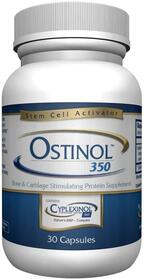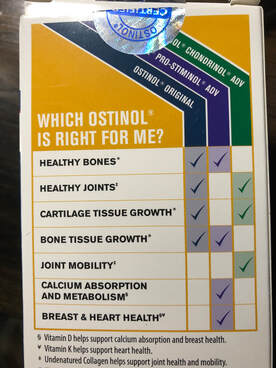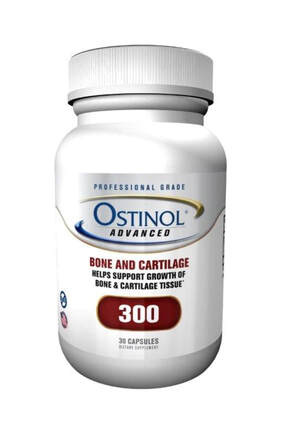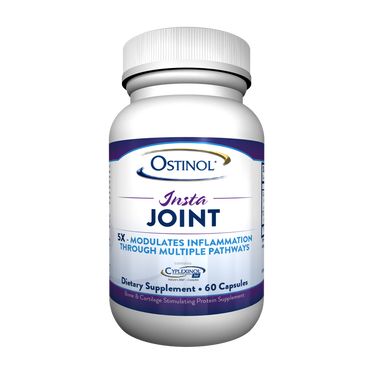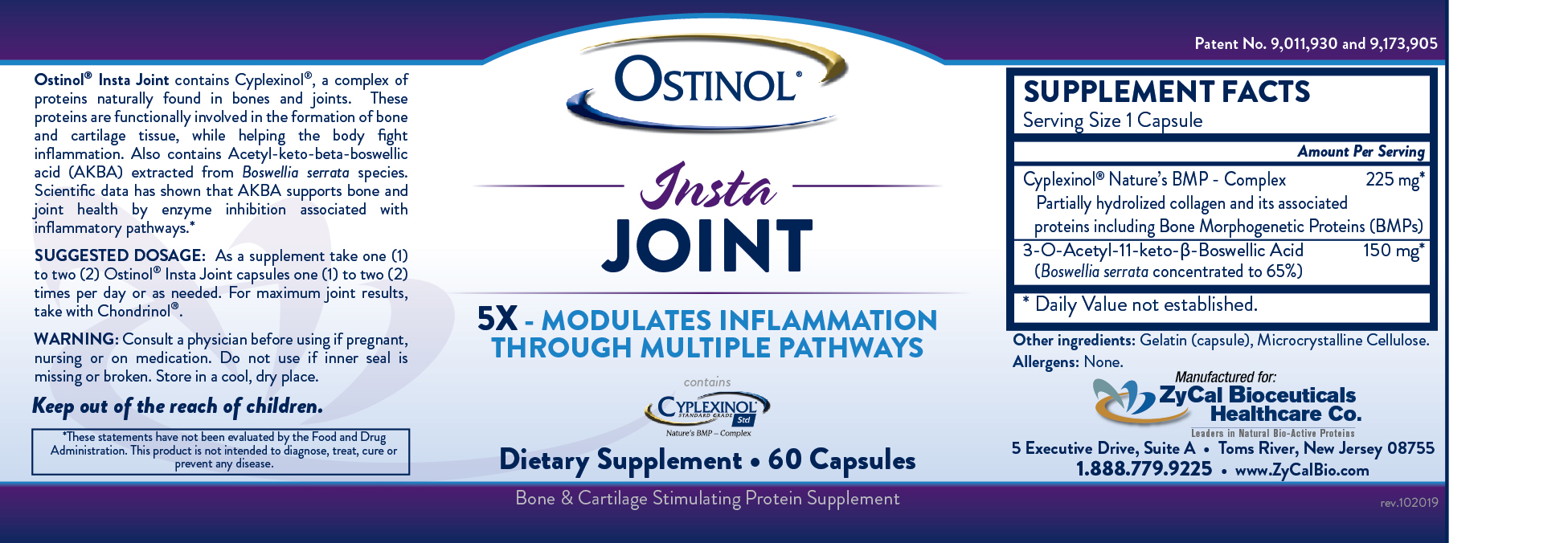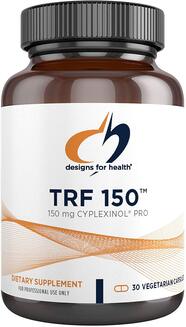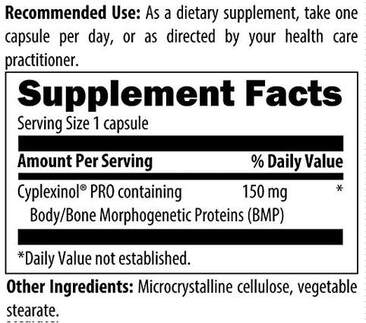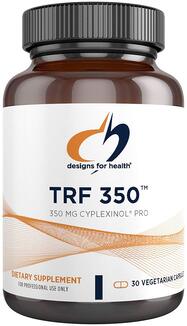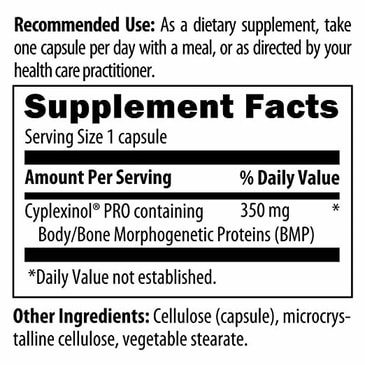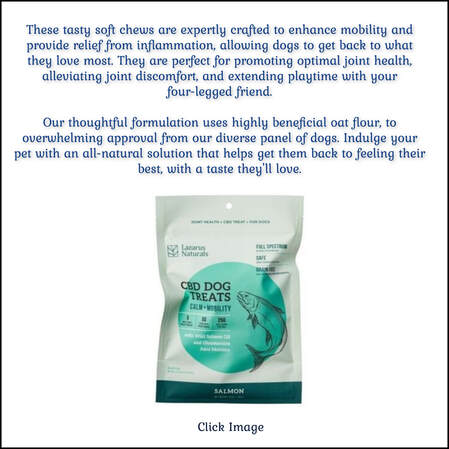Cyplexinol: A Natural BMP Complex with Osteoinductive and Anti- Inflammatory
Activity Promotes De Novo Bone and Joint Tissue Growth
Click image
|
Ostinol™ is a breakthrough in bone and joint health. Ostinol™ transcends traditional supplements for bones and joints, providing the ultimate support for healthy bones, joints and cartilage tissue.
Ostinol™ is:
Ostinol™ is powered by Cyplexinol®, a new class of nutritional ingredient. Cyplexinol® is an all-natural stem cell signaling protein complex which uniquely stimulates key pathways to support your body’s ability to create new bone and cartilage tissue! Additionally, Cyplexinol® provides the benefits of bone health & joint comfort by modulating multiple inflammatory pathways – something no other ingredient delivers! Bioactive protein complexes are backed by over 50 years of scientific and medical research. Before being used as a nutritional supplement, this class of proteins was used by surgeons for years to grow bone and cartilage tissue post-operative. Natural healthcare professionals have been using this powerful bioactive protein complex in Ostinol™ as an oral supplement for bone and joint health with great clinical success and it is now available directly to you as the ultimate supplement in bone and joint health. Buy Ostinol™ today and put your body to work creating new bone and cartilage tissue - your satisfaction is guaranteed. Made in the USA – Non-GMO & Gluten Free Derived from a Certified Organic Source 150mg For people who: need mild support for bone & joint health Available forms: 30 capsules Suggested dosage: one (1) to three (3) capsules per day Key ingredients: Cyplexinol® 300mg For people who: need moderate support for bone & joint health Available forms: 30 capsules Suggested dosage: one (1) to three (3) capsules per day Key ingredients: Cyplexinol® 350mg For people who: need moderate support for bone & joint health Available forms: 30 capsules Suggested dosage: one (1) to three (3) capsules per day Key ingredients: Cyplexinol® 450mg For people who: need advanced bone & joint support Available forms: 30 capsules Suggested dosage: one (1) to three (3) capsules per day Key ingredients: Cyplexinol® Ostinol website WellbeingGPS website For dogs: Approximate dosing: Small dogs: 1-2 capsules (150mg) daily Med dogs: 1-3 capsules (150 or 300mg) daily Large Dogs: 1-3 capsules (300, 350, 450mg) daily Can take about 1-2 weeks before you see results. If your dog is tolerating this for a couple days (no loose stools etc), then you can increase to 2 capsules per day if more is needed. That can be a loading dose until you start to see results ( a couple weeks). The 1 cap per day to start is to make sure your dog does ok on it. If loose stools occur, drop back to half a capsule (open capsule, pour half into wet food and recap for later) for 3-5 days then increase gradually to recommended dose. They make a product for dogs and it is only 50 mg and contains junk ingredients. Avoid it. The ones I have posted on this page are safe. |
|
Ostinol is” a quantum leap in stem-cell activating proteins. Only the protein-complex in Ostinol has been shown to safely turn on stem cells to grow new bone and cartilage tissue. Ostinol is available in three convenient, once-a-day strengths for mild, moderate and severe bone and joint health needs.
THE BENEFITS OF OSTINOL 350: The most unique bone and joint supplement product ever – with proven stem-cell activating complex! Feel younger, stronger, more active. Do more, be more, live life to the fullest. Fast Acting - Improved joint function in days - not weeks! Bio-active protein-complex needed for people suffering with bursitis, tendonitis, arthritic joints. Only bio-active complex that re-grows the bone tissue – so minerals can finally work! The same bio-active proteins in Ostinol have been used by Orthopedic Spine Surgeons for more than 25 years to grow bone and cartilage tissue! This powerful protein complex is now available in a safe, yet powerful form to help you grow new bone and cartilage. This protein complex in Ostinol is so powerful that many people have reported delaying or cancelling surgery. Results may vary depending on condition/severity/strength of product used and frequency of taking it. |
Click images to go to product
Ostinol 300
Insta Joint
- Key ingredients: Cyplexinol® 225 mg, Boswellia serrata extract 150 mg
TRF 150
|
First off, I do not get commissions for this product. I have only used it on my dog and I have seen some wonderful things happen using this. My dog Sydney, 9 yrs old and a 70 lb pit/am bulldog mix was diagnosed with spondylosis and hip dysplasia. At this same time, she had an unknown/undiagnosed condition going on with her right back leg. The knee was bowing out and she was limping pretty heavily. My vet felt it was neurological and at the time I was unsure but it could be. Neurologist felt it was orthopedic. Therapist was unsure but felt maybe it could be the adductor muscle. So lots of guesses but still unknown. After 6 weeks twice a week of hydrotherapy and laser therapy, she was doing better. It took months for her to walk good again but she did. We used a small pool about 30 inches deep to continue therapy throughout the summer.
Fast forward two years. She tore her ACL in her left leg. The opposite leg with the unknown injury/bowing of knee. We went back to hydrotherapy for 6 more weeks and alot of therapy at home and short walks. I purchased two leg braces; one for each leg. I tried everything to help her walk better. She still was struggling to walk. The vet said she would never get better. I didn't have money for surgery so we had to make this work somehow or it could be her time to cross over the rainbow bridge. I cried for a week then in the middle of the night, I woke to think..I am not done. this isn't over. I have got to try to find a solution..something that will work. Again I worked at helping her. Although she was slightly better, it wasn't enough. She still struggled. Someone had recommended TRF 150 to me. I thought, what the heck..I have tried everything else I know of..why not. Although it was kind of expensive I felt it was still worth a try. Two weeks after giving her this, she all of a sudden started walking much better. And now 9 months later..she is still doing good. I missed a week of giving it and she went lame on me. She couldn't hardly walk. I ordered a bottle from Amazon and had it same day. She was back walking fine again. So this is why I think this is an awesome product. Its unique in its type of supplement and also comes recommended by holistic vets. Read below on how it works. It heals/repairs, reduces inflammation and works on pain. It can take 3 days to 2 weeks to really a start working..and up to a month to work well..but I swear by this. Sydney will be on this for the rest of her life. So if you were like me, or have a large dog really having issues, I highly recommend trying this out. You can give it along with other supplements and medications. Sydney is also on Adequan every 3 weeks, Actiflex 2-3 tsp daily, raw diet, and many other supplements including DC-Y herb mix. (You will need a hand grinder since they only come in pellets) I take a break from the DC-Y after 3 months for a month or two. It contains Yucca and Yucca shouldn't be given longer than 3 months without a break. The Yucca in Actiflex is low so is safe to use daily without interruption. For dogs:
Approximate dosing: Small dogs: 1-2 capsules (150mg) daily Med dogs: 1-2 capsules (150 or 350mg) daily Large Dogs: 1-2 capsules (350mg) daily Can take up to 2-3 weeks before you see results. |
|
James J Scaffidi1* and Karen F Vieira2
1ZyCal Bioceuticals Healthcare Co, Shrewsbury, USA 2Deparment of Biomedical Sciences, University of Florida, USA Corresponding Author: James J Scaffidi DNMc, BSc, ZyCal Bioceuticals Healthcare Co., Inc. PO Box 615, Shrewsbury, MA 01545, United States Tel: 1-888-779-9225 (Ext. 101) E-mail: [email protected] Received Date: April 24, 2017; Accepted Date: May 09, 2017; Published Date: May 15, 2017 Citation: Scaffidi JJ, Vieira KF (2017) Cyplexinol: A Natural BMP Complex with Osteoinductive and Anti-Inflammatory Activity Promotes De Novo Bone and Joint Tissue Growth. J Stem Cell Res Ther 7:387. doi: 10.4172/2157-7633.1000387 Copyright: © 2017 Scaffidi JJ, et al. This is an open-access article distributed under the terms of the Creative Commons Attribution License, which permits unrestricted use, distribution, and reproduction in any medium, provided the original author and source are credited. |
|
Abstract
Sustaining the health of the bones and joints is a pertinent issue that is challenging for the medical community nationwide. Chronic inflammation has been implicated as a major contributing factor for the systemic degradation and disruption of the articular and skeletal systems. Accordingly, medical practitioners and pharmaceutical companies are currently directing treatments toward restoring healthy inflammatory response in order to strengthen the human body’s capability to target endogenous degradation of bone and joint tissue. However, improving overall health involves more than targeting inflammation, and should also focus on activating cellular machinery which supports the regeneration of de novo bone and cartilage through a process known as osteoinduction. Bone Morphogenetic Proteins (BMPs) have been identified as the regulators of the osteogenic differentiation of Mesenchymal Stem Cells (MSCs) into multiple cell lineages such as osteoblasts and chondrocytes. Cyplexinol® is a natural BMP complex, which consists of a collagen fragment matrix with the BMPs and endogenous growth factors bound within and to the matrix. Upon oral administration of the BMP-complex, the BMP moieties bind to receptors within the GI lumen where they quickly confer both osteoinductive and anti-inflammatory activity. It is the osteogenic properties of the BMPs which differentiate the MSCs into osteoblasts to promote the growth of de novo bone tissue, providing the critical surface for minerals to bind to healthy bones. Similarly, the osteoinductive proteins have also been proven to turn MSCs into chondrocytes for new cartilage tissue growth via proteoglycan excretion. This review will describe clinical work which demonstrates the efficacy of Cyplexinol®, highlighting how this supplement induces MSC differentiation. |
|
Introduction
The preservation of bones and joint health is at the forefront of medical issues nationwide. Key statistical reports indicate that osteopenia and osteoporosis are major health problems for about 54 million people over the age of 50 in the United States (US) [1]. This number represents approximately 55% of individuals in this age group. It has been estimated that more than 52 million people in the US would be affected by this health issue by 2010, and it is proposed that this figure will increase to more than 60 million by the year 2020 [2]. Osteoporosis has also been implicated as the cause for at least two million cases of bone fracture as well as 19 billion dollars in annual medical costs [2]. It is estimated that this cost will rise to about 25 billion annually by 2025. In relation to joint problems, the Centers for Disease Control and Prevention (CDC) reports that an estimated 54 million Americans have arthritis or another form of rheumatic disease, with an expected increase of 78 million cases by the year 2040 [3]. The term “arthritis” in fact denotes over 100 different conditions that affect the joints. Osteoarthritis (OA) is the most common form of arthritis, followed by other forms such as Rheumatoid Arthritis (RA), lupus, and gout [3]. Symptoms associated with bone and/or joint damage include pain, stiffness, inflammation, and swelling. Chronic inflammation, in particular, has been implicated as a contributing factor for the systemic degradation and disruption of the articular and skeletal systems [4]. Indeed, inflammation is usually present in the joints before an individual begins to experience physical symptoms such as pain or the loss of mobility. Overexertion of the bones, joint overuse, gradual degeneration, or blunt trauma induce Pathogen- and Damage-Associated Molecular Patterns (PAMPS and DAMPS), which signal the immune system that there is a state of infection, damage, etc., that requires a directive in terms of combating the infection or beginning the repair process. The development of chronic inflammation that affects damaged joints is attributed to pro-inflammatory by-products that emanate from a damaged Extracellular Matrix (ECM) such as DAMPS, hyaluronan, and fibronectin. This leads to synovial abnormalities and increased synovial fluid volume [5,6]. Hyperplasia of the synovium, infiltration of mononuclear cells, fibroblast-like synoviocyte activation, and the production of catabolic mediators (such as matrix Metalloproteinases (MMPs), interleukin-1 beta (IL-1β), and tumor necrosis factor alpha (TNF-α)) also play a role in joint destruction [7]. Synovitis is a secondary response; this cascade induces the thickening of the synovium as well as the release of destructive proteases and inflammatory cytokines that further damage articular cartilage [5]. Research indicates that joint injury of almost any kind may contribute to the onset of conditions such as OA. In some cases, however, they may also occur in conjunction with bone sclerosis, capsular fibrosis, and osteophyte formation [5,8]. |
|
Osteopenia and osteoporosis that subsequently develop in a number of cases are characterized by the loss of bone mass, the microarchitectural deterioration of bone tissue, and osteoclastic bone resorption that leads to increased bone fragility and enhanced fracture risk [9]. Increased osteoclast activity results in the heightened pumping of protons through active ion channels into the extracellular space. This process lowers the pH of the microenvironment and causes bone mineral to deteriorate [10]. Type 1 collagen is also degraded during bone resorption and this leads to the accumulation of by-products (including calcium) that are released into the blood and excreted from the body through the kidneys. However, again, inflammation plays a major role in the progression of pathophysiological changes.
Research has shown that fibronectin activity induces the production of pro-inflammatory cytokines such as MMP-1, MMP-3, IL-1β, and TNF-α, which are associated with the development of a severe form of shoulder joint damage called chrondrolysis, which is characterized by the abrupt loss of joint cartilage [4]. An additional pro-inflammatory pathway involves the increased expression of cyclooxygenase 2 (COX- 2), cytokines, apoptosis inhibitors, and growth factors. NF-kappa β also plays a significant role in the accelerated breakdown of bone, thereby promoting osteoclastic activity over osteoblastic activity. Indeed, NFkappa β activation contributes to the onset of a process called Receptor Activator NF-Kappa β Ligand (RANKL)-induced osteoclast formation. The NF-kappa β pathway is primarily activated by pro-inflammatory cytokines such as IL-1 and is, thusly, a promising therapeutic target for bone and cartilage conservation [11]. Accordingly, medical practitioners and pharmaceutical companies are more aggressively directing treatment approaches toward proinflammatory modulation as a means of strengthening the human body’s ability to withstand the endogenous degradation of bone and joint tissue. However, the key to improving overall health involves not only addressing inflammation, but also targeting the cellular pathways that support the regeneration of de novo bone and cartilage, a process known as osteoinduction. Osteoinduction involves the differentiation of Mesenchymal Stem Cell (MSC) progenitors into distinct cells such as osteoblasts or chondrocytes [12-14]. |
|
It is well known that bone and joint tissue genesis essentially share a common mechanism. In particular, MSCs differentiate into multiple cell lineages such as chondrocytes, fibroblasts, osteoblasts, and myoblasts, among others, and this leads to the formation of almost all bone, joint, and connective tissue types (e.g., cartilage, tendons, or ligaments) [14]. The activation of MSCs also facilitates healing within injured joints and damaged bones. That is, chondrogenic differentiation of MSCs promotes cartilage regeneration, whereas the osteogenic differentiation of MSCs into osteoblasts facilitates the integration of mineralized bone matrix proteins into bone [14,15]. This entire process is regulated by Bone Morphogenetic Proteins (BMPs), which belong to the Transforming Growth Factor-ß (TGF-ß) protein superfamily [16]. Growth factors such as basic Fibroblast Growth Factor (bFGF), Insulin-like Growth Factor-1 (IGF-1), Vascular ENdothelial Growth Factor (VEGF), and insulin-like growth factor (IGF) also support the maturation of nascent osteoblasts and chondrocytes [17-24].
In 2006, an oral natural ingredient called Cyplexinol® was developed. To date, it is the only protein complex that is comprised of BMPs and the active growth factors TGF-ß, bFGF, VEGF, and IGF. They are naturally bound to a specialized form of collagen in their natural physiologic levels. This protein complex has been proven to be an osteoinductive complex capable of stimulating the formation of de novo bone and cartilage since its discovery in 1965 [25], It has been successfully used in surgery to grow bone and cartilage since the 1980s. This supplement is derived from an organic food source and is suitable for oral administration. Cyplexinol® can naturally manage bone and cartilage health. A currently unmet medical need. Accordingly, this review will focus on the clinical work demonstrating the efficacy of Cyplexinol® to date, highlighting how this BMP-complex induces MSC differentiation. |
|
Bone Morphogenetic Proteins as Regulators of Osteoinduction
Research shows that chondrogenic stimulants such as BMPs, particularly BMP-6, increase the deposition of the cartilage matrix [26]. In addition, BMP signaling has been shown to influence the growth of fibrocartilaginous tissue which comprises the integration sites of tendons or ligaments with the bone [27]. Furthermore, BMP-7 has demonstrated the ability to promote tendon/bone integration and healing [28]. The initiation of these processes is dependent upon the activation of Smads 1, 5 and 8. More specifically, Smads 1, 5, and 8 are directly phosphorylated by the BMP-activated type I receptor and this leads to the formation of heteromeric complexes with Smad-4 [29]. Without BMP-activated type I receptor activation, the N-terminal Mad Homology (MH1) and C-terminal MH2 domains of Smads become linked and subsequently anchored as dimers to the plasma membrane. However, following receptor activation and phosphorylation of Smads 1, 5, and 8, the interaction between the MH1 and MH2 domains is disrupted, thereby allowing the formation of hetero-oligomers with Smad4. After the hetero-oligomer forms, the entire complex is translocatesd into the nucleus where it acts in cooperation with other transcription factors, co-activators and co-repressors that induce the expression of BMP-responsive genes. Id proteins, which play a role in the stimulation of BMP activity, are also induced in response to the Smad1/Smad 5 pathway. Therefore, BMPs appear to elicit some of their biological activity through Id proteins that are regulated by Smads 1 and 5 [29]. Finally, the activated Smad complex stimulates the expression of genes that promote the differentiation of MSCs into different cell lineages such as chondrocytes and osteoblasts. Once differentiation occurs, the underlying matrix can be remolded and repaired. Cyplexinol® was developed as an extract which contains the natural physiologic balance of BMPs and growth factors that are capable of stimulating de novo cartilage and bone growth. |
|
Cyplexinol® Safety and Clinical Efficacy
Accordingly, for the past 10 years, Cyplexinol® has been used orally as a natural ingredient in many supplements that promotes the osteogenic differentiation of MSCs. The safety profile for the oral administration of a BMP-complex was established in animal models as far back as 1993, in which animals (rats) were fed up to 100 times the normal human dose of a BMP-Complex and no adverse effects occurred [30] Furthermore, a 2002 study involving murine models for both type I (estrogen deficiency) and type II (senile) osteopenia/osteoporosis demonstrated the negative effects of bone loss. First, it was observed that reduced bone formation resulted in lower numbers of adult MSCs as well as decreased osteogenic activity and proliferation. The second observation was that decreased proliferation was subsequently coupled with increased apoptosis in MSC cultures obtained from osteopenic mice. However, this study showed that the systemic administration of recombinant human bone morphogenetic protein (rhBMP-2), a highly osteoinductive protein, to osteopenic mice promoted the osteogenic differentiation of MSCs as well as increased proliferation, a decrease in apoptosis, and enhanced bone formation activity [31]. In older osteopenic male mice, rhBMP-2 treatment also resulted in the restoration of articular and epiphyseal cartilage width to the levels that were observed in young mice [31]. One additional animal study involved the administration of 10 μg of BMP-6, which is one of the BMPs that Cyplexinol® is comprised of, to ovarectomized rats. Micro computed technology (micro-CT) analyses BMPof the distal femurs in the BMP-6 treated animals demonstrated an increase in bone volume of 78%. Furthermore, BMP-6 treatment also increased the osteoblast surface for 32% and decreased the osteoclast surface for 29% of the animals in the treatment group in comparison to the control (ovarectomized-only) and sham groups. Therefore, the results showed that BMP-6 is a systemic bone anabolic agent that restores bone inductive capacity, microarchitecture, and quality of the skeleton in osteoporotic rats [32]. BMP-6 administration was also evaluated in an in vitro model involving human articular chrondrocyte samples that were obtained from individuals with or without OA. The key findings from the study were that BMP-6 stimulated the growth and repair of joint tissue in both healthy and OA samples, and independent of OA, BMP-6 increased biosynthesis of proteoglycans cartilage building blocks [33], thereby suggesting a homeostatic role in maintaining the integrity of adult cartilage. Chondrocytes play a major role in the development and repair of the ECM of cartilage by synthesizing matrix components such as proteoglycans and glycosaminoglycan side chains, and secreting them into the ECM [34]. Therefore, these results demonstrate that BMP-induced MSC differentiation has the ability to initiate the regeneration of the underlying architecture of numerous tissue types within the joints [29]. |
|
A similar study also showed that BMP-4 and BMP-5 expression was significantly decreased in the synovial tissue samples of participants with RA and OA in comparison to the tissue samples of Normal Donors (NDs) [35]. These findings indicate that BMP plays a specific role in joint homeostasis that is disrupted by inflammatory and/or degenerative joint diseases, but also that BMP supplementation has restorative properties on the joints.
The animal and in vitro studies were followed by clinical trials that also demonstrated the safety of taking the BMP-complex Cyplexinol®. In a 2012 open-label, randomized, prospective trial, 28 participants with OA (mean age 61 years) were given Cyplexinol® plus glucosamine/ chondroitin in a combined tablet daily for 4 weeks. The participants showed a rapid response to the treatment as early as seven days after the supplementation commenced [25]. Furthermore, pain and frequency of pain continually decreased as treatment continued. Participants reported an overall 55% reduction in pain by week 4, with increases in strength and overall activity [25]. None of the participants reported adverse effects. In 2013, a larger, randomized, double-blind, placebo-controlled trial was conducted and 87 participants (55+ years) with OA-related joint pain were recruited. The participants were randomized into a treatment group that received 150 mg of Cyplexinol® alone, daily for 12 weeks, or a placebo group. The results showed statistically significant improvements in pain and stiffness, with an onset of action that occurred by day seven [36]. The gradual improvement of symptoms continued to week 12. The participants in the treatment group also reported a heightened quality of life in comparison to the controls (placebo group). More specifically, 90% of participants experienced less pain and improved quality of life at 12 weeks. None of the participants withdrew due to adverse side effects. |
|
Furthermore, in a 2013 case study, a 59-year old woman diagnosed with menopause-associated osteoporosis and suffering from a progressive loss of bone mass who was administered 200 mg of Cyplexinol® twice daily for 34 months showed significant improvement in her DEXA scores. In particular, after taking calcium and vitamin D3 for 53 months her DEXA scored declined from -2.0 to -3.3 or moderate osteoporosis. Then, 200 mg Cyplexinol® twice daily was added and by month 8 of Cyplexinol® use, the subject’s bone scans indicated a cessation of bone loss. By 34 months the subject’s bone density score increased 51% from baseline [37], thereby supporting previous evidence which shows the ability of BMPs to promote bone regeneration. More recently, an open-label, prospective trial was conducted in 2015 which involved 44 participants (55+ years) with self-reported OA/ degenerative joint disease. About 68.2% of the enrolled participants were diagnosed with OA, and all of the participants were given 150 mg Cyplexinol® alone, daily for 4 weeks. Overall, the participants showed a 49% decrease in joint pain, an 80% improvement in affected joint strength, and a 57% improvement in activity levels by week 4 in comparison to baseline visual analog scale (VAS) scores) [38]. Furthermore, no adverse events or required form of rescue treatment were reported by any of the participants. Therefore, there is sufficient supportive evidence for the safety and efficacy of the BMP-complex Cyplexinol®. |
|
Cyplexinol® Mechanism of Action
Cyplexinol® is a BMP-Complex that is extracted from certified organic, closed-herd, bovine femurs. The hydroxyapatite component of the bone is removed, leaving behind the native, partially hydrolyzed collagenous network of type 1 collagen and associated growth factors. Chief among these growth factors are TGF-β, IGF, bFGF, VEGF, and isoforms of BMPs [38]. The partially hydrolyzed collagen protects the active proteins and ensures their delivery to receptors in the Gastrointestinal (GI) mucosa, where they confer their osteoinductive activity upon MSCs [39]. In particular, the tertiary conformation of the proteins and collagen resists enzymatic and hydrolytic degradation. Furthermore, bioavailability studies have demonstrated that the target specificity of BMP can be attributed to the presence of BMP-7 receptors in the stomach and ileum of animals, which transport the active peptide rather than peptides that have been hydrolyzed into amino acids [40]. The presence of additional BMP receptors, in the gastrointestinal system have also been identified through animal models [41]. Accordingly, BMP-2, BMP-4, and BMP-7 are expressed in gastrointestinal tissues, where they have been shown to play a significant role in the regulation of cellular proliferation and differentiation [16]. Studies have also indicated that Smad 4, which forms a heteromeric complex with Smads 1, 5, and 8 after they are phosphorylated by BMP-activated type I receptor, is localized in the gastrointestinal system [42]. Therefore, the BMP signaling pathway facilitates the delivery and absorption of biologically active BMPs. |
|
Once the osteoinductive properties of the BMPs within the Cyplexinol® complex have been conveyed through the GI receptors, the osteogenic differentiation of MSCs into osteoblasts occurs, followed by the growth of de novo bone tissue and mineralization [37]. Similarly, the osteoinductive proteins that comprise Cyplexinol® have also been proven to turn MSCs into chondrocytes for new cartilage tissue growth via proteoglycan excretion [33]. However, in addition to facilitating the proper cellular groundwork for tissue regeneration, BMP activation can have a rapid response on pain signaling in the joint due to interleukin regulation/feedback [29]. The proliferation of inflammatory cytokines, such as IL-1 and IL-6, within the joint space can have detrimental effects on joint tissue. IL-1, in particular, activates MMPs and the NFKappa B transcription factor, while elevated IL-6 levels leads to chronic inflammation. Accordingly, Cyplexinol® has been shown to downregulate the activation of pro-inflammatory cytokines such as IL-1 and IL-6 [36]. More specifically, this natural ingredient demonstrated the ability to disrupt the IL-1 and IL-6 inflammatory pathways in as little as seven days [36]. This positions Cyplexinol® as a truly unique ingredient that elicits a rapid anti-inflammatory effect. More importantly, the BMPof complex, Cyplexinol®, disrupts inflammatory pathways that would otherwise augment joint damage and in doing so, promotes joint health.
Discussion Overall, clinical research has demonstrated the efficacy of Cyplexinol® in addressing both bone and joint health [25,36,37], thereby offering both healthy individuals as well as those affected by osteoarthritis and osteoporosis an alternative for optimal bone and joint health. In particular, scientific research demonstrates that this supplement provides benefits to the joints in as little as seven days; that this osteoinductive BMP-complex promotes the regeneration of joint and bone tissue; that it helps supports a healthy bone density, and that it encourages a healthy inflammatory response [25,36-38]. However, in addition to the osteoinductive capabilities of Cyplexinol®, research also shows that BMPs exert widespread anti-inflammatory activity [36] that includes the regulation of GI inflammation, thereby making it a promising ingredient for promoting GI health. |
|
References
The National Osteoporosis Foundation (2017) What is osteoporosis and what causes it? International Osteoporosis Foundation(2015) Women over 50 will experience osteoporotic fractures as well men. Centers for Disease Control and Prevention (2016) Arthritis: Improving the quality of life for people with arthritis at a glance. Sokolove J, Lepus CM (2013) Role of inflammation in the pathogenesis of osteoarthritis: latest findings and interpretations. TherAdvMusculoskelet Dis 5:77-94.[PubMed] Ayral X, Pickering EH, Woodworth TG, Mackillop N, Dougados M (2005)Synovitis: a potential predictive factor of structural progression of medial tibiofemoral knee osteoarthritis -- results of a 1 year longitudinal arthroscopic study in 422 patients. Osteoarthritis Cartilage13:361-367.[PubMed] Freemont AJ (1996)The pathophysiology of cartilage and synovium. Br J Rheumatol35: 10-13. Keyszer G, Redlich A, Häupl T, Zacher J, Sparmann M, et al. (1998) Differential expression of cathepsins B and L compared with matrix metalloproteinases and their respective inhibitors in rheumatoid arthritis and osteoarthritis: a parallel investigation by semiquantitative reverse transcriptase-polymerase chain reaction and immunohistochemistry. Arthritis Rheum 41:1378-1387.[PubMed] Hutton CW (1989) Osteoarthritis: the cause not result of joint failure? Ann Rheum Dis 48:958-961.[PubMed] (1993) Consensus development conference: Diagnosis, prophylaxis, and treatment of osteoporosis. Am J Med 90:646-650.[PubMed] Blair HC, Teitelbaum SL, Ghiselli R, Gluck S (1989)Osteoclastic bone resorption by a polarized vacuolar proton pump. Science 245:855-857.[PubMed] Novack D (2005) Role of NF-kB in the skeleton. Cell Res 21:169-182.[PubMed] Raisz LG (2005) Pathogenesis of osteoporosis: concepts, conflicts, and prospects. J Clin Invest 115:3318-3325.[PubMed] Garrett IR (2007)Anabolic agents and the bone morphogenetic protein pathway. Curr Top DevBiol78:127-171.[PubMed] Marion NW, Mao JJ (2006)Mesenchymal stem cells and tissue engineering. Methods Enzymol420:339-361.[PubMed] Westhrin M, Xie M, Olderøy MØ, Sikorski P, Strand BL, et al. (2015)Osteogenic differentiation of human mesenchymal stem cells in mineralized alginate matrices. PLoS One 10:e0120374.[PubMed] Bragdon B, Moseychuk O, Saldanha S, King D, Julian J, et al. (2011) Bone morphogenetic proteins: a critical review. Cell Signal23:609-620.[PubMed] McCarthy TL, Centrella M, Canalis E (1989) Regulatory effects of insulin-like growth factors I and II on bone collagen synthesis in rat calvarial cultures. Endocrinology 124:301-309.[PubMed] Noda M, Camilliere JJ (1989) In vivo stimulation of bone formation by transforming growth factor-beta. Endocrinology 124:2991-2994.[PubMed] Celeste AJ, Iannazzi JA, Taylor RC, Hewick RM, Rosen V, et al. (1990) Identification of transforming growth factor beta family members present in bone-inductive protein purified from bovine bone. ProcNatlAcadSci USA 87:9843-9847.[PubMed]
| ||||||||||
**Canine Arthritis And Joint is intended for informational, educational and entertainment purposes only and is not a substitute for medical advice, diagnosis or treatment. Do not attempt to self-diagnose or treat any health condition. You should always consult with a healthcare professional before starting any diet, exercise or supplementation program, before taking any medication, or if you have or suspect your pet might have a health problem. The opinions expressed by Canine Arthritis And Joint are not to be replaced for medical care. This website and the information contained herein have not been evaluated by the Food and Drug Administration. The information and opinions on Canine Arthritis And Joint are not intended and cannot be used to diagnose, treat, cure, or prevent any disease. This applies to people and pets!
This site uses affiliate links such as banners you may see that allows for paid commissions.
This site uses affiliate links such as banners you may see that allows for paid commissions.
Canine Arthritis And Joint © Copyright 2015-2024
Designed By Paw Prints Web Design
Designed By Paw Prints Web Design

